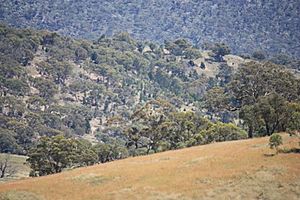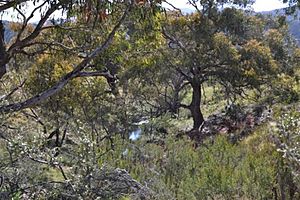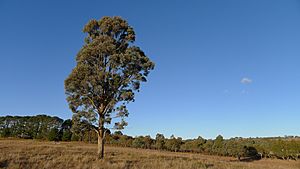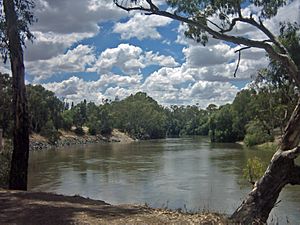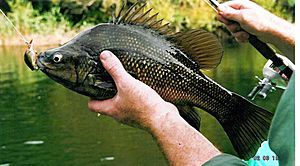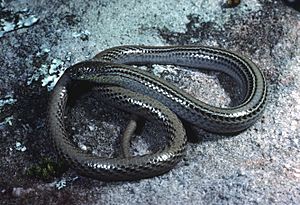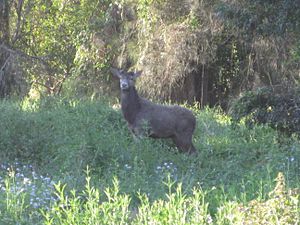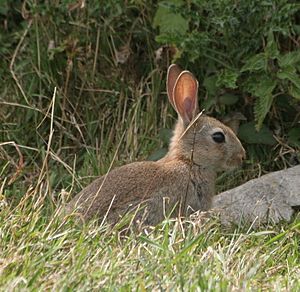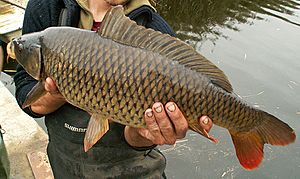Scottsdale Reserve facts for kids
Quick facts for kids Scottsdale ReserveNew South Wales |
|
|---|---|
| Nearest town or city | Bredbo, New South Wales |
| Established | 2006 |
| Area | 13.28 km2 (5.1 sq mi) |
| Managing authorities | Bush Heritage Australia |
| Website | Scottsdale Reserve |
Scottsdale Reserve is a large nature reserve covering about 1,328 hectares (3,282 acres). It is located on the Murrumbidgee River in southern New South Wales, Australia. The reserve is about 79 kilometers (49 miles) south of Canberra and 4 kilometers (2.5 miles) north of Bredbo.
Bush Heritage Australia (BHA) owns and manages Scottsdale Reserve. They bought the land in 2006. This purchase helped connect important natural areas, like the Kosciuszko to Coast (K2C) project. Before 2006, the land was used for farming, mostly for sheep. About a quarter of the reserve had its native plants cleared away.
The land of Scottsdale Reserve traditionally belongs to the Ngunnawal people. Aboriginal people likely lived here because of the many resources. These included the Bogong moth and the daisy yam. The Murrumbidgee River provided fish, like the trout cod. This fish is now an endangered species. The river also gave water for animals that Aboriginal people hunted for food. These animals included the brushtail possum, eastern grey kangaroo, and swamp wallaby.
Contents
Plants and Animals of Scottsdale Reserve
Scottsdale Reserve is home to many different plants and animals. There are over 217 plant species and 142 animal species. This includes 113 types of birds. Many of these species live in two special habitats that are in danger:
- Yellow box grassy woodlands (critically endangered)
- Natural temperate grassland (critically endangered)
Other plant areas in the reserve include:
- Scribbly gum-black cypress pine forest
- Tablelands frost hollow grassy woodlands
Plants
Scottsdale Reserve has a big program to bring back native plants. They have a nursery on site where they grow plants. These include grasses like river tussock (Poa labillardierei). They also grow shrubs like silver wattle (Acacia dealbata). Trees like yellow box (Eucalyptus melliodora) are also grown.
The reserve is also home to the rare silver-leafed mountain gum (Eucalyptus pulverulenta). Only about ten natural groups of this tree are left in Australia. It is listed as vulnerable to extinction. The team at Scottsdale is growing these trees. They are also looking for good places to plant them.
Natural Temperate Grasslands
Before Europeans arrived, the southern tablelands of the ACT and NSW had huge areas of native grasslands. Today, less than 3% of these original grasslands remain. This is because of changes like land clearing, grazing by farm animals, and invasive plants. Farmers also changed the soil by using fertilisers. This led to smaller, separated patches of grassland.
Natural temperate grasslands have native grasses that grow in clumps. These include kangaroo grass (Themeda triandra), snowgrass (Poa sieberiana), and river tussock grass (Poa labillardierei). Other grasses like speargrass (Austrostipa sp.) and wallaby grasses (Austrodanthonia sp.) are also found here.
About 90 hectares of Scottsdale Reserve used to be natural temperate grassland. This grassland was next to Gungoandra Creek. It followed a line of ponds and frost hollows. Before replanting, removing weeds is a big job. They use methods like herbicide, scraping the soil, and burning. This helps reduce weed seeds in the ground. In April 2014, they planted seeds of 11 different native grasses and 30 wildflowers. After 7 months, surveys showed that many good plants were growing. They were spreading into other parts of the reserve too.
Yellow Box Grassy Woodlands
In New South Wales, grassy box woodlands have tall Eucalypt trees. The types of trees change depending on how much rain an area gets. At Scottsdale Reserve, the main eucalypts are yellow box (Eucalyptus melliodora) and red gum (Eucalyptus blakelyi). There are not many shrubs, but you might see Grevillea, Acacia, and Cassinia plants. The ground is covered with grasses and other small plants.
Millions of hectares of grassy box woodlands once covered NSW. Now, less than 10% remains. Clearing land for farming broke up these woodlands into small pieces. Conservation efforts now focus on connecting these pieces.
A lot of the cleared yellow box grassy woodland is now covered in African lovegrass (Eragrostis curvula). This is a problem in the Monaro region. The team at Scottsdale and many volunteers have planted 20,000 young native trees. They hope these trees will grow and shade out the lovegrass. They are trying different ways to restore the land. This helps them learn the best methods for the reserve.
It has been hard for native trees like Eucalyptus and Allocasuarina to grow back naturally in farming areas. This is because of farming activities like tilling the soil and grazing. Weeds also invade damaged land. These things make it harder for eucalypts and other important plants to regrow. Grazing by animals seems to be the main reason why eucalypts don't grow back well. This is because farm animals change the soil. They also eat young seedlings, which stops them from surviving. In areas without farm animals, there can be many more young eucalypt plants.
At Scottsdale, over 4,000 yellow and white box eucalypts were planted. After 18 months, 96.5% of them were still alive. This success is because there are no farm animals in these areas. Also, strong tree guards protect the young plants from animals like the swamp wallaby and rabbits.
Murrumbidgee River Habitat
Scottsdale Reserve is working with the Upper Murrumbidgee Demonstration Reach. They have planted a 6-kilometer (3.7-mile) habitat corridor. This corridor runs between Bredbo and the Colinton Gorge. It will improve the home for threatened fish like the murray cod, macquarie perch, and trout cod. They are trying a method called long-stem planting. This involves planting tall Eucalyptus viminalis trees along the river. They are also planting 17,000 Poa labillardierei grasses.
Areas along the river that have been grazed less have more types of shrubs. These shrubs are part of the grassy box woodlands. Having more shrubs creates a more complex plant structure. This helps support a wider variety of bird species.
Most of the land along the Murrumbidgee River is privately owned. Farm animals getting into the river areas has caused a lot of damage. They trample plants, eat them, and cause soil erosion. Fences can help control farm animals. However, native animals like kangaroos and wallabies can also cause damage. Fences don't stop them as easily.
Animals
Scottsdale Reserve is home to many animals, both native and introduced. Some threatened species found here include Rosenberg’s monitor (Varanus rosenbergi), the speckled warbler (Pyrrholaemus sagittatus), brown treecreeper (Climacteris picumnus), macquarie perch (Macquaria australasica), and striped legless lizard (Delma impar). Scottsdale has special programs to protect the macquarie perch and striped legless lizard.
Macquarie Perch: Life Cycle and Protection
The macquarie perch is one of three threatened fish in the Upper Murrumbidgee River. The others are murray cod (Maccullochella peelii) and trout cod (Maccullochella macquariensis). This native Australian freshwater fish lives in the southeastern part of the Murray-Darling River System. It prefers clear, flowing water.
In the 1970s, the number of macquarie perch started to drop. They were found in fewer places. This led to them being listed as nationally endangered. Today, dams and the long distances between small groups of fish increase the risk of them dying out.
Researchers from the University of Canberra are working with the Scottsdale team to protect this fish. They are finding where the fish lay their eggs using underwater listening posts and special tags. This helps them understand what affects the fish's survival. Fishing is often blamed for the decline of macquarie perch. However, environmental factors like changes in water flow and carp eating them have a much bigger impact.
Striped Legless Lizard: Habitat and Conservation
The striped legless lizard likes native grasslands that have not been disturbed. It prefers areas with thick clumps of grass, like kangaroo grass (Themeda triandra). Building new homes and widespread farming have destroyed much of the lizard's habitat. Only about 3% of undisturbed temperate grasslands are left in southeastern Australia.
The striped legless lizard uses tussock grasses for shelter. This helps it control its body temperature and stay moist. It also chooses habitats where it can hide from predators, like birds of prey. The lizard also needs places with plenty of insects to eat. A big challenge in protecting this lizard is keeping its genes diverse. This is hard because its habitat is broken up, and the lizard groups are small.
One of the actions at Scottsdale is helping to move striped legless lizards. These lizards are moved from building sites in Canberra. Fenced areas were set up before the lizards were moved. Their original habitat was natural treeless grasslands. After humans disturbed the land, this threatened lizard now lives in small, separated areas of secondary grasslands. These are grasslands where trees have been removed.
Trout Cod: Bringing Them Back
Trout cod have been raised in hatcheries. Then, they are released into the Murrumbidgee River near Narrandera. This is an effort to increase the number of these threatened fish. This method is common for increasing threatened fish populations. However, the fish raised in hatcheries often don't survive well. This is because they act differently from wild fish.
More success was seen when wild trout cod were moved. More of these wild fish survived after 12 months. Over 60% of the wild fish survived, while less than 10% of the hatchery fish were still present.
Environmental Challenges
Scottsdale Reserve works to reduce environmental threats. This helps protect the endangered ecosystems and species. Main threats include:
- Feral animals: Grazing and hunting by pigs, deer, rabbits, cats, carp, and foxes. The reserve uses trapping and baiting to control them.
- Invasive weeds: Such as African lovegrass, serrated tussock, St. John's wort, and briar rose. They have used herbicides in the past. Now, they are trying new ways to control them.
- Erosion: This is when soil is washed away. They build leaky weirs and flumes. They also plant ground cover to stop erosion.
European Rabbits: A Big Problem
European rabbits were brought to Australia in 1788. They quickly became a serious pest. Rabbits dig burrows called warrens. These burrows disturb the soil around them. Weeds then grow easily in this disturbed soil, pushing out native plants. Rabbits also eat a lot of native plants, damaging the landscape. They have a big impact on new shrubs growing. Protecting new plants from rabbits can be expensive.
Scottsdale has an active program to reduce rabbits. Volunteers check and bait warrens every 3 months. Because of this, the number of active rabbit sites has dropped. It went from nearly 60% of 320 identified warrens to about 20%.
African Lovegrass: An Invasive Weed
African lovegrass is the most serious weed at Scottsdale. It has taken over much of the land that was once cleared for farming. It often forms thick patches in similar areas in southeastern NSW. This weed spreads very easily. It chokes out native plants in poor soils. It also changes how fires behave, which can harm the ecosystem.
Sometimes, large rural lands are divided into smaller properties. People who buy these smaller properties might not know much about weeds. This makes the problem even worse if they don't control the weeds effectively.
Carp: An Unwanted Fish
The common carp (Cyprinus carpio) was brought to Australia about 150 years ago. It has become the most common fish in the Murray Darling Basin. It can make up to 90% of all fish by weight. Carp are very invasive. They are considered a pest in most Australian states. This is because they eat a lot of other things. They also reproduce well in altered waterways, where native fish often need more varied water currents.
Bush Heritage Australia and the Upper Murrumbidgee Demonstration Reach are doing research. They want to find better ways to deal with this pest. The research includes tracking carp using special tags. They also trap carp to remove them. This helps them estimate how many carp there are and find where they breed.
How Scottsdale Reserve is Managed
Bush Heritage Australia (BHA) has five main goals for managing the ecosystems at Scottsdale Reserve:
- Cleared woodlands: By 2030, they want to restore cleared yellow box woodland areas with yellow box trees and other related plants.
- Valley floor: By 2030, they aim to increase native grassland by 20%. They also want to protect the plants that are already there.
- Murrumbidgee River: By 2020, they plan to restore the habitat along and in the Murrumbidgee River.
- Gungoandra Creek: By 2030, they want to make Gungoandra Creek and its smaller streams stable.
- Dry forest areas: By 2030, these areas should support important plant and animal species.
To reach these goals, many volunteers help at Scottsdale Reserve. They do things like large-scale planting in cleared areas. They also grow plants in the on-site nursery. And they help control weeds in the remaining native plant areas.
|



